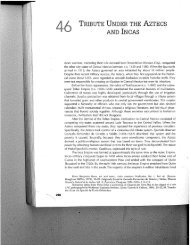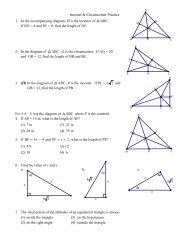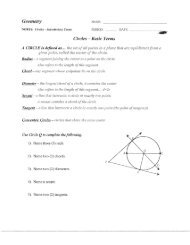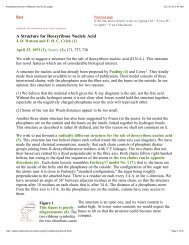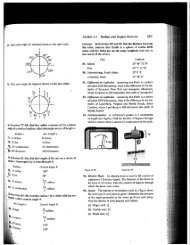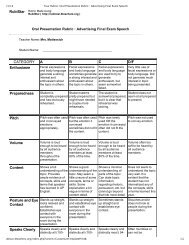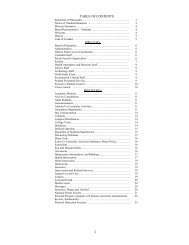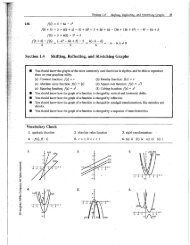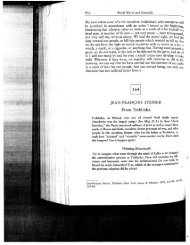The Byzantine Empire - Pascack Valley Regional School District
The Byzantine Empire - Pascack Valley Regional School District
The Byzantine Empire - Pascack Valley Regional School District
Create successful ePaper yourself
Turn your PDF publications into a flip-book with our unique Google optimized e-Paper software.
200<br />
New Faith and New Commerce<br />
PART III o <strong>The</strong> Postclassical Period, 500-1450:<br />
bureaucratic corruption, although her severe retaliation<br />
against personal enemies brought criticism.<br />
Supplementing the centralized imperial authority<br />
was one of history most elaborate bureaucracies.<br />
Trained in Greek classics, philosophy, and science in a<br />
secular school system that paralleled ctmrch education<br />
for the priesthood, <strong>Byzantine</strong> bureaucrats could be<br />
recruited fi’om all social classes. As in China, aristocrats<br />
predominated, but talent also counted among this<br />
elite of highly educated scholars. Bureaucrats were specialized<br />
into various offices, and officials close to tire<br />
emperor were mainly eunuchs. Provincial governors<br />
were appointed fi’om the center and were charged<br />
with keeping tabs on military authorities. An elaborate<br />
system of spies helped preserve loyalty while creatmg<br />
intense distrust even among friends. It is small wonder<br />
that the word Byzar~ti’rze came to refer m complex institutional<br />
arrangements. State control of the church and<br />
its appointment of head church oiticials was another<br />
key aspect of the government structure.<br />
Careful military organization arose as well, as Figqare<br />
9.2 suggests. <strong>Byzantine</strong> rulers adapted the later Roman<br />
system by recruiting troops locally and rewarding them<br />
with grants of land in return for their military service.<br />
<strong>The</strong> land could not be sold, but sons inherited its administration<br />
in return for continued military responsibility.<br />
Many outsiders, particularly Slavs and Armenian Christians,<br />
were recruited ibr the army in this way. Increasingly,<br />
hereditary ntilitary leaders assumed regional powm;<br />
displacing more traditional and better-educated aristocrats.<br />
One emperor; Michael II, was a product of dais system<br />
and was notorious for his hatred of Greek education<br />
and his overall personal ignorance. On the other hand,<br />
the military system had obvious advantages in protecting<br />
a state rec~rrendy under attack ii’om Muslims of various<br />
sorts--Persians, Arabs, and later Turks--as well as<br />
nomadic intruders from central Asia. Until the I5th century,<br />
tbe <strong>Byzantine</strong> <strong>Empire</strong> eftkctively blocked the path<br />
to Europe for most of these groups.<br />
Socially and economically, the empire depended<br />
on Constantinople’s control over the countryside, with<br />
tbe bureaucracy regulating trade and centre!ling food<br />
prices. <strong>The</strong> large peasant class was vital in supplying<br />
goods and providing the bulk of tax revenues. Food<br />
prices were kept artificially low, to content the numerous<br />
urban lower classes, in a system supported largely<br />
by taxes on the hard-pressed peasantry. Other cities<br />
were modest in size--for example, Athens dwindled-because<br />
the focus was on the capital city and its food<br />
needs- <strong>The</strong> empire developed a fa~flung trading network<br />
with Asta to the east and Russia and Scandinavia<br />
re the n6rth. Silk production expanded in the empire,<br />
with silkworms and techniques initially imported from<br />
China, and various luxury products, including cloth,<br />
carpets, and spices, were sent north. This gave the<br />
empire a favorable trading position with less sophisticated<br />
lands. Only China produced luxury goods of<br />
comparable quality. <strong>The</strong> empire also traded actively<br />
with India, the Arabs, and east Asia while receiving simpler<br />
products from western Europe and Africa. At the<br />
same time, the large merchant class never gained significant<br />
political power, ira part because of the elaborate<br />
network of government controls. In this,<br />
Byzantium again resembled China and differed<br />
notably from the looser social grid political network.s of<br />
the West, where memhants were gaining greater votce.<br />
<strong>Byzantine</strong> cultural life centered on the secular traditions<br />
of Hellenism, so irrlportant in the education of<br />
bureaucrats, and on the evolving traditions of Eastern,<br />
or Orthodox, Christianity. <strong>The</strong> <strong>Byzantine</strong> strength lay in<br />
preserving and commenting on past forms more than in<br />
developing new ones. Art and architecture were exceptions;<br />
a distinct <strong>Byzantine</strong> style deve!oped ti~irly early.<br />
<strong>The</strong> adaptation of Rotnan domed buildings, the elaboration<br />
of powerful and richly colored religious mosaics,<br />
and a tradition of icon paintings--paintings of saints<br />
FI6~RI~ 9.4 Just as theologians through the (<br />
worked to understand Christ’s message, so to(<br />
struggled to capture his image. This powerful mosaic<br />
at the Church of Chora in Istanbul was created in<br />
of the 14th century. Notice the difference betweer<br />
and the images,of Ghrist common in Western<br />
place more emphasis on suffering end less on divine



